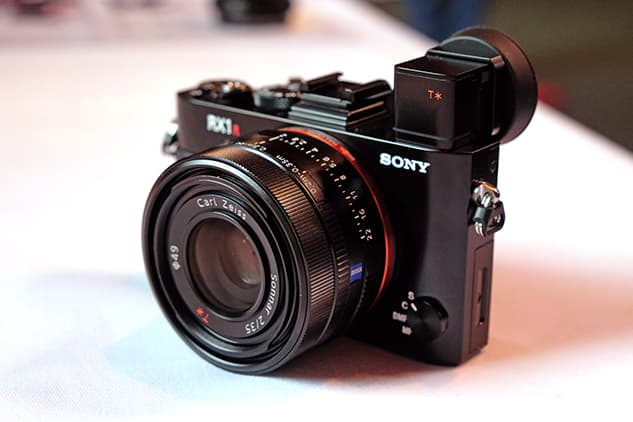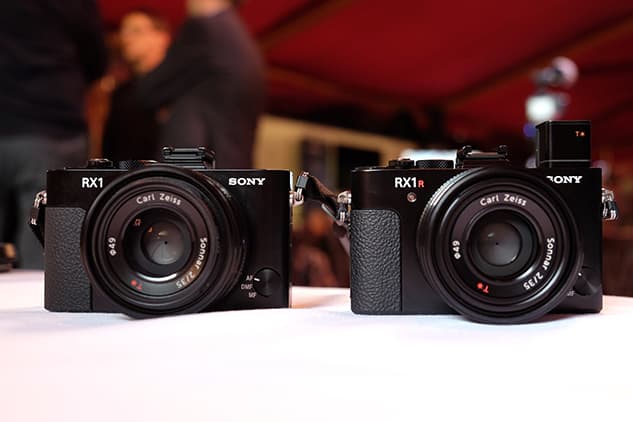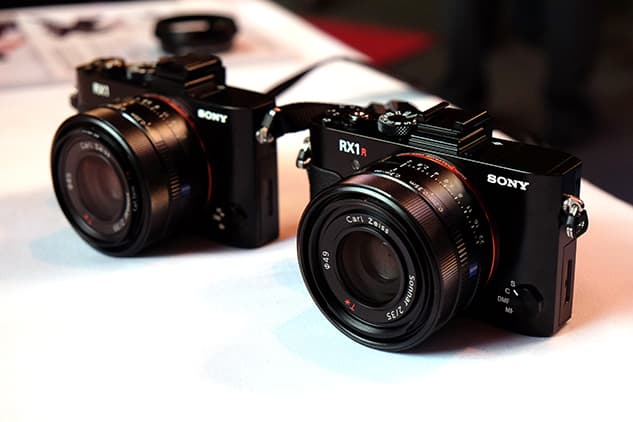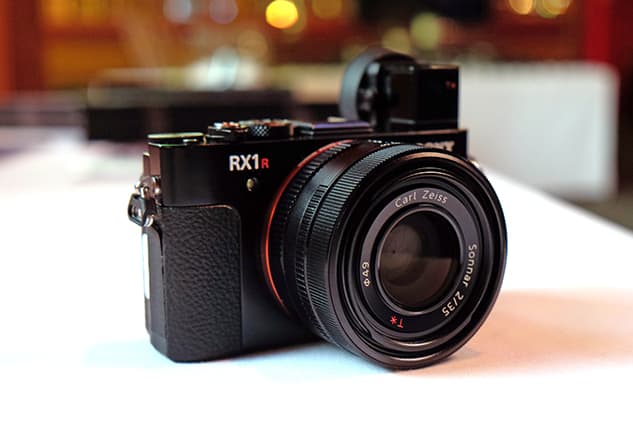Just when we believed we’d seen everything from Sony this year, the manufacturer recently made a surprise announcement and unveiled its latest full-frame compact camera – the Cyber-shot DSC-RX1R II. Arriving just four months after the launch of the sensational Leica Q (Typ 116), the RX1R II looks set to challenge competition in the full-frame compact camera market by introducing a compelling set of cutting-edge features. Although it’s hard to distinguish from its predecessors in terms of its design, there’s a lot more to the RX1R II than first meets the eye. With a headline-grabbing 42.4-million-pixel sensor, retractable electronic viewfinder, hybrid autofocus system and the world’s first optical variable low-pass filter, there’s certainly no shortage of new features to get excited about and look at more closely.

AP’s Michael Topham tries out the new Sony Cyber-shot RX1R II at the official launch in Munich, Germany
Features
Just like the original RX1 and RX1R, the RX1R II sports a fixed 35mm f/2 Zeiss Sonnar T* lens with a nine-blade diaphragm. Directly behind the lens lies a 42.4-million pixel, back-illuminated Exmor R CMOS sensor that works in tandem with Sony’s BIONZ X image processor to deliver an ISO range of 100-25,600 (expandable to ISO 50-102,400). It’s usually at this point that we reveal whether the sensor is equipped with an optical low-pass filter or not, but the RX1R II is one of a kind in the way it boasts the world’s first optical variable low-pass filter.

The Sony Cyber-shot RX1R II on display at launch with its electronic viewfinder raised from the top plate
Until now we’ve been used to seeing cameras equipped with and without optical low-pass filters, but never before have we seen a camera with an optical variable low-pass filter that lets the user take control of the low-pass filter effect. The new filter system achieves this by applying voltage to a liquid crystal layer that’s sandwiched between two low-pass filters to control what Sony calls a light-splitting function. The result of this light-splitting function lets the user choose the degree of low-pass filter effect.
Users will find three settings available in the menu, with ‘off’ prioritising the highest image resolution, ‘Hi’ prioritising moiré and colour artefact reduction, and ‘standard’ balancing both priorities. In addition to controlling the low-pass filter effect, Sony has introduced a low-pass filter bracketing function that, much like exposure bracketing, can be used to capture the effects of different settings before analysing and choosing the best result. Although we have yet to test and compare the results of this new optical low-pass filter, we can foresee this technology creeping its way into other Sony cameras in the future.

The Sony Cyber-shot RX1R II is supplied with a removable rubber eyepiece cup that attaches to the viewfinder
Another novel feature of the RX1R II is its 2.4-million-dot OLED electronic viewfinder – something the original RX1/R didn’t have. Just like the viewfinder on Sony’s RX100 IV, it pops up from the corner of the top-plate, replacing what was the pop-up flash on the RX1/R. Although there will be some who will miss an in-built flash, there is still the option to attach an external flashgun via the hotshoe on the top-plate. Back to the EVF in question, it boasts an impressive 0.74x magnification, automatically detects when it’s raised to the eye and comes with a rubber eyepiece cup, which helped to cushion it against my eye during our time with the camera. Viewing of images at the rear has also been improved with a newly added tilting 3in, 1,228,800-dot screen. Although the resolution remains the same and it’s not a touch-sensitive display, the way it can be angled by up to 109° upward and 41° downward is an improvement on the fixed screen of old.
The RX1R II’s autofocus credentials are impressive too. The fast hybrid autofocus system it uses introduces continuous autofocus (AF-C) to an RX1-series camera for the first time, and as well as focusing 30% faster than the RX1R, it’s possible to shoot a continuous burst at up to 5fps while AF tracking is deployed. There are as many as 399 phase-detection points covering 45% of the image area and a further 25 contrast-detection points – another clue to suggest the RX1R II inherits many of its internal features from Sony’s flagship CSC, the Alpha 7R II.
Other noteworthy features include 14-bit uncompressed raw shooting and the option to shoot in multiple aspect ratios with 4:3 (38MP), 16:9 (36MP) and 1:1 (28MP), all supported as well as the native 3:2. One of the biggest surprises is the absence of 4K video, despite the RX1R II sharing the same sensor as the Alpha 7R II, which can shoot 4K internally. One theory is that the size and design of the body may not meet the heat-dissipation requirements for 4K video, thus leaving it out and settling for full HD video instead, which can be recorded at 60p (50p) 30p (25p) or 24p frame rates. There’s a 3.5mm port for connecting an external microphone and the camera accepts Sony’s NP-BX1 battery, which lasts for approximately 220 shots.

The Sony Cyber-shot RX1R II (right) looks very similar in terms of its design to the original RX1 (left)
Just as you’d expect, the RX1R II is Wi-Fi/NFC equipped and there’s the option of adding additional functions to the camera such as time lapse (£7.99), motion shot (£3.99) and light painting (£3.99) by downloading Sony’s PlayMemories apps.
Build and handling
The RX1R II maintains the excellent build quality of the RX1/R, and with a robust metal body it feels like a solid and refined piece of kit. In the hand it is just as comfortable to hold and operate as the RX1/R, with a relatively simple layout of buttons and everything you need within easy reach to take full manual control. Aperture, macro mode and manual focusing are controlled by simply rotating the rings around the lens barrel with your left hand, with exposure compensation quick to adjust from the corner of the body with your right thumb.
It’s the addition of the viewfinder, though, that really changes the way you work with the RX1R II. Being able to pop the EVF up in an instant and instinctively lift the camera to your eye, rather than hold the camera away from your body and compose via the rear screen, makes it feel like you’re better connected to the camera and you’re using a much more serious tool. My brief hands-on experience with the camera reminded me of all the things I love about the RX1-series cameras, and there’s something truly special about the 35mm focal length, which for me, at least, feels better matched to reportage and documentary photography than the wider 28mm lens on the Leica Q.
First Impressions
With the large-sensor compact camera area of the market growing in value and the increasing competition in the market from rival manufacturers, it was only a matter of time before Sony revisited the RX1-series cameras to look at how it could improve upon its original RX1/R. The RX1R II is much more than a minor update, and the new and improved features combine to make it an extremely attractive proposition for serious photographers as well as professionals who want a small, light and incredibly powerful full-frame fixed-lens compact.

First impressions of the RX1R II are excellent. We can’t wait for our review sample to arrive in the next few weeks
I struggled to put the camera down during our brief hands-on session and just wanted to continue using it, which is testament to a product that feels great in the hand and produces excellent results. It RX1R II does have its pros and cons when you compare it directly to the Leica Q, but one thing in its favour is its price. Whereas the Leica Q will set you back a cool £2,900, the launch price of the Sony RX1R II will be £2,600 when it goes on sale in December. Having been teased with a brief touch-and-try session at the official launch, the arrival of our review sample can’t come soon enough.
Interview with Kimio Maki
While attending the Sony press event in Munich, we caught up with Kimio Maki, Senior General Manager of the Digital Imaging Business Group, Sony Corporation. As well as answering questions about both cameras, Kimio Maki described Sony’s future strategy. Find out what he said to say in our interview.










